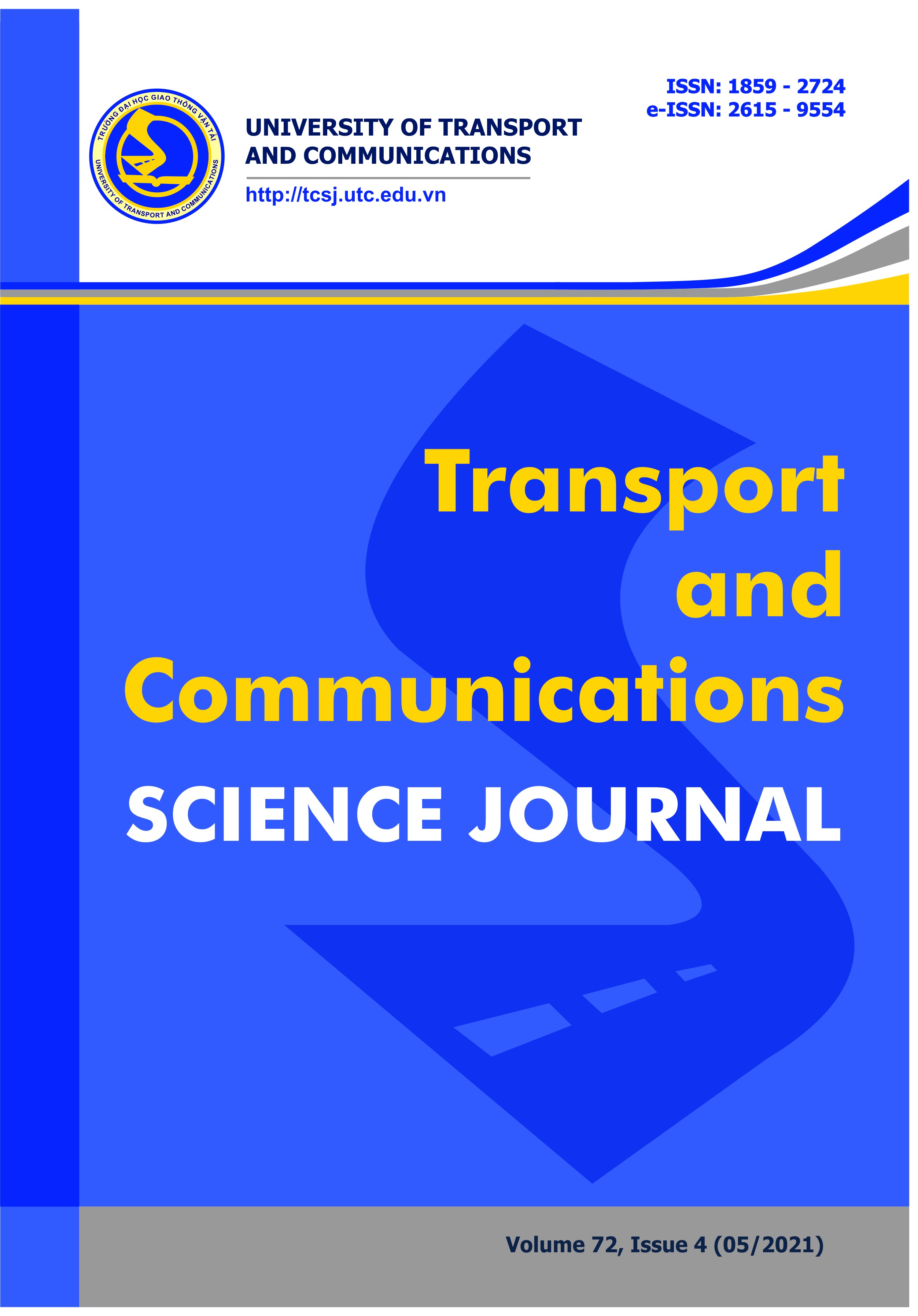An experimental study on production of high strength non-shrink grout containing fly ash
Email:
thuychi.dang@utc.edu.vn
Từ khóa:
Non-shrink, high compressive strength, grout, self – levelling
Tóm tắt
Cement-based grouts are widely used thanks to its outstanding features such as high workability, non-separation, non-bleeding, easy to fulfill small gaps with complex shapes. This paper descrcibes the first phase of a series of laboratory experiments that examined the ability of production of self - levelling mortar at the University of Transport and Communications. The Portland cement-based grout incorporated superplasticizer, fly ash, fine aggregate, water along with expansion agent to match as closed as possible the given high strength non-shrink grout. The experimental study focused on the performance of non-shrink grouts regarding the flowability, expansion and bleeding, strengths and drying shrinkage of the test grout mixtures. The high range water reducer (HRWR) at dosage of 1% by weight of cement was used as a flowability modifying chemical admixture to prevent water segregation and leads to an increase in compressive strength. The parameter tests consist of water-cement ratios, and fixed dosages of superplasticizer and expansive agent. To examine the flowability of grout mortars, the flow cone test was applied. The flow cone test result indicated that there were three proportional of grouts that can meet the requirement of fluidity. The compressive strength of specimens was tested according to ASTM C349-14. It was concluded that the compositions of grouts at a water-cement ratio of from 0.29 to 0.33 have compressive strengths greater than 60 MPa. The tested specimens using the expansive agent with the dosage recommended by the manufacturer meet the non-shrinkage requirement of a grout. The experimental results have demonstrated the ability of production of high strength non-shrink grouts.Tài liệu tham khảo
[1]. M. R. Azadia, A. Taghichianb, A. Taheric, Optimization of cement-based grouts using chemical additives, Journal of Rock Mechanics and Geotechnical Engineering, 9 (2017) 623-637. https://doi.org/10.1016/j.jrmge.2016.11.013
[2]. T. B. Nguyen, B. V. Tran, Research on manufacturing high strength self-levelling grout with ultra thin polypropylene fiber, The 8th Conference for Young Researchers, Vietnam Institute for Buildings Science and Technology, (2011). (In Vietnamese).
[3]. Q. V. Vu, Experimental research results on the production of non-shrink grout for repair of Ta Duong dike, Bac Ninh province, (2012). (In Vietnamese) http://www.vncold.vn/Web/Content.aspx?distid=2907
[4]. ASTM C33-08, Standard Specification for Concrete Aggregates, (2008). https://www.astm.org/DATABASE.CART/HISTORICAL/C33C33M-08.htm
[5]. ASTM C1437-07, Standard Test Method for Flow of Hydraulic Cement Mortar, (2007). https://www.astm.org/DATABASE.CART/HISTORICAL/C1437-15.htm
[6]. ASTM C940-16, Standard Test Method for Expansion and Bleeding of Freshly Mixed Grouts for Preplaced-Aggregate Concrete in the Laboratory, (2016). https://www.astm.org/Standards/C940
[7]. ASTM C349-14, Standard Test Method for Compressive Strength of Hydraulic-Cement Mortars (Using Portions of Prisms Broken in Flexure), (2014). https://www.astm.org/DATABASE.CART/HISTORICAL/C349-14.htm
[8]. ASTM C157-14, Standard Test Method for Length Change of Hardened Hydraulic-Cement, Mortar, and Concrete, (2014). https://www.astm.org/Standards/C157
[9]. TCVN 9204:2012, Packaged dry, hydraulic-cement grout (non-shrink), (2012). (In Vietnamese). https://vanbanphapluat.co/tcvn-9204-2012-vua-xi-mang-kho-tron-san-khong-co
[10]. G. Lambardi, The role of cohesion in cement grouting of rock, Proceedings of the 15th International Congress on Large Dams, (1985), 235-260.
[2]. T. B. Nguyen, B. V. Tran, Research on manufacturing high strength self-levelling grout with ultra thin polypropylene fiber, The 8th Conference for Young Researchers, Vietnam Institute for Buildings Science and Technology, (2011). (In Vietnamese).
[3]. Q. V. Vu, Experimental research results on the production of non-shrink grout for repair of Ta Duong dike, Bac Ninh province, (2012). (In Vietnamese) http://www.vncold.vn/Web/Content.aspx?distid=2907
[4]. ASTM C33-08, Standard Specification for Concrete Aggregates, (2008). https://www.astm.org/DATABASE.CART/HISTORICAL/C33C33M-08.htm
[5]. ASTM C1437-07, Standard Test Method for Flow of Hydraulic Cement Mortar, (2007). https://www.astm.org/DATABASE.CART/HISTORICAL/C1437-15.htm
[6]. ASTM C940-16, Standard Test Method for Expansion and Bleeding of Freshly Mixed Grouts for Preplaced-Aggregate Concrete in the Laboratory, (2016). https://www.astm.org/Standards/C940
[7]. ASTM C349-14, Standard Test Method for Compressive Strength of Hydraulic-Cement Mortars (Using Portions of Prisms Broken in Flexure), (2014). https://www.astm.org/DATABASE.CART/HISTORICAL/C349-14.htm
[8]. ASTM C157-14, Standard Test Method for Length Change of Hardened Hydraulic-Cement, Mortar, and Concrete, (2014). https://www.astm.org/Standards/C157
[9]. TCVN 9204:2012, Packaged dry, hydraulic-cement grout (non-shrink), (2012). (In Vietnamese). https://vanbanphapluat.co/tcvn-9204-2012-vua-xi-mang-kho-tron-san-khong-co
[10]. G. Lambardi, The role of cohesion in cement grouting of rock, Proceedings of the 15th International Congress on Large Dams, (1985), 235-260.
Tải xuống
Chưa có dữ liệu thống kê

Nhận bài
14/04/2021
Nhận bài sửa
21/05/2021
Chấp nhận đăng
24/05/2021
Xuất bản
27/05/2021
Chuyên mục
Công trình khoa học
Kiểu trích dẫn
Dang Thuy, C. (1622048400). An experimental study on production of high strength non-shrink grout containing fly ash. Tạp Chí Khoa Học Giao Thông Vận Tải, 72(4), 477-485. https://doi.org/10.47869/tcsj.72.4.7
Số lần xem tóm tắt
424
Số lần xem bài báo
363









